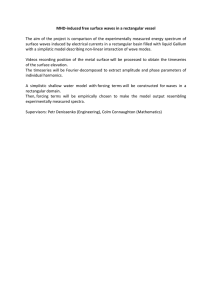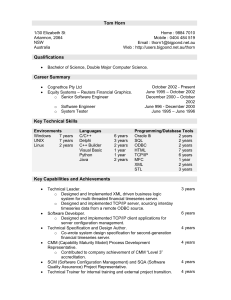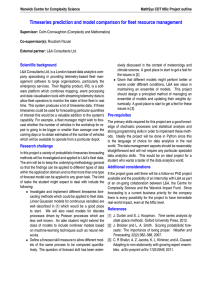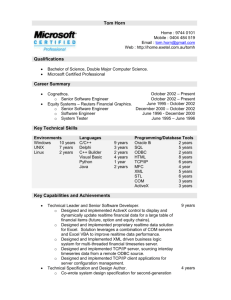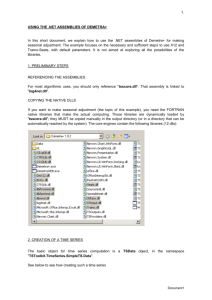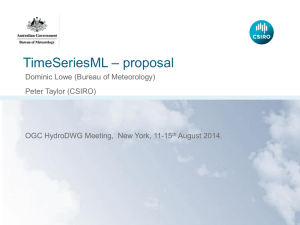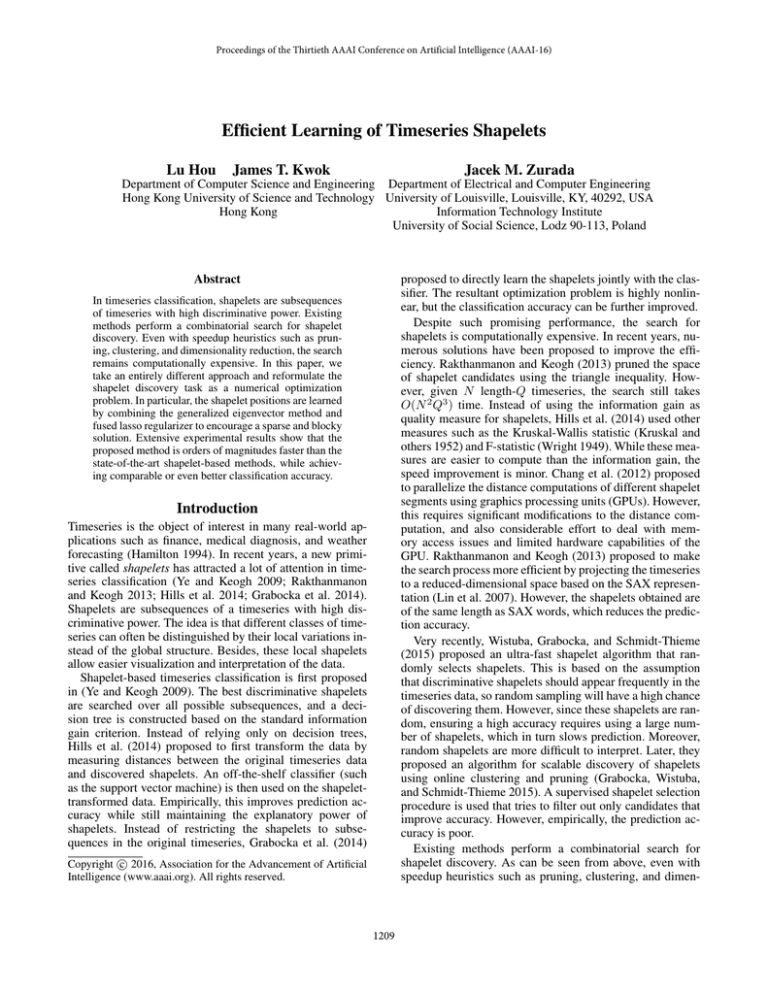
Proceedings of the Thirtieth AAAI Conference on Artificial Intelligence (AAAI-16)
Efficient Learning of Timeseries Shapelets
Lu Hou
James T. Kwok
Jacek M. Zurada
Department of Computer Science and Engineering Department of Electrical and Computer Engineering
Hong Kong University of Science and Technology University of Louisville, Louisville, KY, 40292, USA
Hong Kong
Information Technology Institute
University of Social Science, Lodz 90-113, Poland
proposed to directly learn the shapelets jointly with the classifier. The resultant optimization problem is highly nonlinear, but the classification accuracy can be further improved.
Despite such promising performance, the search for
shapelets is computationally expensive. In recent years, numerous solutions have been proposed to improve the efficiency. Rakthanmanon and Keogh (2013) pruned the space
of shapelet candidates using the triangle inequality. However, given N length-Q timeseries, the search still takes
O(N 2 Q3 ) time. Instead of using the information gain as
quality measure for shapelets, Hills et al. (2014) used other
measures such as the Kruskal-Wallis statistic (Kruskal and
others 1952) and F-statistic (Wright 1949). While these measures are easier to compute than the information gain, the
speed improvement is minor. Chang et al. (2012) proposed
to parallelize the distance computations of different shapelet
segments using graphics processing units (GPUs). However,
this requires significant modifications to the distance computation, and also considerable effort to deal with memory access issues and limited hardware capabilities of the
GPU. Rakthanmanon and Keogh (2013) proposed to make
the search process more efficient by projecting the timeseries
to a reduced-dimensional space based on the SAX representation (Lin et al. 2007). However, the shapelets obtained are
of the same length as SAX words, which reduces the prediction accuracy.
Very recently, Wistuba, Grabocka, and Schmidt-Thieme
(2015) proposed an ultra-fast shapelet algorithm that randomly selects shapelets. This is based on the assumption
that discriminative shapelets should appear frequently in the
timeseries data, so random sampling will have a high chance
of discovering them. However, since these shapelets are random, ensuring a high accuracy requires using a large number of shapelets, which in turn slows prediction. Moreover,
random shapelets are more difficult to interpret. Later, they
proposed an algorithm for scalable discovery of shapelets
using online clustering and pruning (Grabocka, Wistuba,
and Schmidt-Thieme 2015). A supervised shapelet selection
procedure is used that tries to filter out only candidates that
improve accuracy. However, empirically, the prediction accuracy is poor.
Existing methods perform a combinatorial search for
shapelet discovery. As can be seen from above, even with
speedup heuristics such as pruning, clustering, and dimen-
Abstract
In timeseries classification, shapelets are subsequences
of timeseries with high discriminative power. Existing
methods perform a combinatorial search for shapelet
discovery. Even with speedup heuristics such as pruning, clustering, and dimensionality reduction, the search
remains computationally expensive. In this paper, we
take an entirely different approach and reformulate the
shapelet discovery task as a numerical optimization
problem. In particular, the shapelet positions are learned
by combining the generalized eigenvector method and
fused lasso regularizer to encourage a sparse and blocky
solution. Extensive experimental results show that the
proposed method is orders of magnitudes faster than the
state-of-the-art shapelet-based methods, while achieving comparable or even better classification accuracy.
Introduction
Timeseries is the object of interest in many real-world applications such as finance, medical diagnosis, and weather
forecasting (Hamilton 1994). In recent years, a new primitive called shapelets has attracted a lot of attention in timeseries classification (Ye and Keogh 2009; Rakthanmanon
and Keogh 2013; Hills et al. 2014; Grabocka et al. 2014).
Shapelets are subsequences of a timeseries with high discriminative power. The idea is that different classes of timeseries can often be distinguished by their local variations instead of the global structure. Besides, these local shapelets
allow easier visualization and interpretation of the data.
Shapelet-based timeseries classification is first proposed
in (Ye and Keogh 2009). The best discriminative shapelets
are searched over all possible subsequences, and a decision tree is constructed based on the standard information
gain criterion. Instead of relying only on decision trees,
Hills et al. (2014) proposed to first transform the data by
measuring distances between the original timeseries data
and discovered shapelets. An off-the-shelf classifier (such
as the support vector machine) is then used on the shapelettransformed data. Empirically, this improves prediction accuracy while still maintaining the explanatory power of
shapelets. Instead of restricting the shapelets to subsequences in the original timeseries, Grabocka et al. (2014)
c 2016, Association for the Advancement of Artificial
Copyright Intelligence (www.aaai.org). All rights reserved.
1209
(where α1 , α2 are regularization parameters and v1 is the
1 norm of v) encourages parameter estimates at successive
features
to be similar (Tibshirani et al. 2005). The first term
i |vi − vi−1 | is often called the total-variation (TV) regularizer. The fused lasso regularizer can be written more compactly as α1 Dv1 + α2 v1 , where D is a matrix such that
Di,i = 1, Di,i+1 = −1, and Di,j = 0 otherwise. Because
of the use of both the TV- and 1 -regularizers, the fused
lasso solution is simultaneously blocky and sparse (Rinaldo
2009).
sionality reduction, the search remains computationally expensive. In this paper, we take an entirely different approach
and reformulate the shapelet discovery task as a numerical
optimization problem. To ensure that the obtained shapelets
are discriminative, we consider using a state-of-the-art feature extraction technique called the generalized eigenvector
method (Karampatziakis and Mineiro 2014). On the other
hand, to ensure that the shapelets are local, we employ
sparse modeling techniques that are now commonly used
in various machine learning applications (Bach et al. 2012).
Since a timeseries is a time-ordered list of observations, we
preserve the order information by using the fused lasso regularizer (Tibshirani et al. 2005). The discriminative sparse
blocks identified from the timeseries data are then used as
shapelets. As for the optimization problem associated with
the resultant model, it can be efficiently solved by the alternating direction method of multipliers (ADMM) (Boyd
et al. 2011). Extensive empirical results on a large number
of benchmark timeseries data sets show that the proposed
method is orders of magnitudes faster than the state-of-theart, while achieving comparable or even better classification
accuracies.
Proposed Method
We first consider the simpler scenario of binary classification. Let SN = {(x1 , y1 ), . . . , (xN , yN )} be the training set
of N timeseries samples, where each timeseries xi ∈ RQ is
of length Q, and yi ∈ {±1} is its class label.
By adding a fused lasso regularizer on the GEM formulation, we can obtain sparse, blocky indicator vector for the
shapelet location. The optimization problem becomes:
min v C2 v + α1 Dv1 + α2 v1 : v C1 v = 1,
v
N
N
where Ck = i=1 I(yi = k)xi x
i /
i=1 I(yi = k) is the
covariance matrix of class k (here, I(·) denotes the indicator
function which returns 1 when the argument is satisfied, and
0 otherwise). Note that using only the v1 regularizer produces solutions with weak block structures, while using only
Dv1 produces solutions that are blocky but not sparse.
1v
2v
or vv C
returns the
In GEM, maximizing either vv C
C2 v
C1 v
most discriminative projection direction. Similarly, we can
swap the roles of C1 , C2 in (2), and use C2 as the dominant
class instead. This leads to:
Related Work
Generalized Eigenvector Method (GEM)
The GEM is a state-of-the-art supervised feature extraction
technique (Karampatziakis and Mineiro 2014). While principal component analysis (PCA) is unsupervised and finds
directions that maximize the projected data variance, GEM
finds the direction v that maximizes the ratio of projected
data variances between classes i and j:
v = arg max
v
v Ci v
: v v = constant,
v Cj v
min v C1 v + α1 Dv1 + α2 v1 : v C2 v = 1.
(1)
v
where Ck is the sample covariance matrix of class k. Up to
a scaling on v, (1) can be rewritten as:
(2)
(3)
ADMM Solver
The optimization problems in (2) and (3) have the same
form. In this section, we focus on how to efficiently solve
(2) using the alternating direction method of multipliers
(ADMM) (Boyd et al. 2011). The whole procedure, which
will be called FLAG (Fused LAsso Generalized eigenvector
method) in the sequel, is shown in Algorithm 1.
First, (2) can be rewritten as
v = arg min v Cj v : v Ci v = 1.
v
Intuitively, this direction is discriminative as the information in one class is maximally retained while the other is
compressed. Moreover, compared with other well-known
discriminative feature extraction methods such as Fisher
LDA (Fisher 1936) and sliced inverse regression (Li 1991),
GEM is advantageous in that it uses the covariance matrix
instead of simply the conditional mean.
minv,y,z
v C2 v + α1 z1 + α2 y1
s.t.
Dv = z, v = y, v C1 v = 1.
Setting aside the constraint v C1 v = 1, the augmented Lagrangian is:
Fused Lasso
In recent years, sparse modeling has been commonly used
in diverse areas such as computer vision, signal processing,
and bioinformatics. It selects a relevant subset of features
while simultaneously learning the model. The most popular
sparse modeling algorithm is the lasso (Tibshiranit 1996),
which uses the 1 penalty to encourage sparsity.
In many applications, the features in a sample are ordered. For example, observations in a timeseries are ordered by time. While the lasso ignores
this order information, the fused lasso regularizer α1 i |vi − vi−1 | + α2 v1
L(v, z, y, λt1 , λt2 )
=
v C2 v + α1 z1 + α2 y1
t
+λt
1 (Dv − z) + λ2 (v − y)
ρ1
ρ
2
+ Dv − z2 + v − y2 ,
2
2
where λt1 , λt2 are dual variables at the tth iteration, and ρ1 , ρ2
are penalty parameters. At the (t + 1)th iteration, the values
of v, z and y are updated by minimizing L(v, z, y, λt1 , λt2 )
w.r.t. them in an alternating manner.
1210
From Shapelet Indicator to Shapelets
Algorithm 1 FLAG.
Input: timeseries of length Q, parameters α1 , α2 , ρ1 , ρ2 ,
stopping threshold .
Output: shapelet indicator vector v.
When class 1 is used as the dominant class, let there are B
nonzero blocks in the obtained shapelet indicator vector v,
with the tth block starting at time st and ending at et , i.e.,
v = [0, . . . , 0, vs1 , . . . , ve1 , 0, . . . , 0, vsB . . . , veB , 0, . . . , 0].
1: Initialize: compute covariance matrices C1 and C2 ,
2:
3:
4:
5:
6:
7:
8:
9:
10:
11:
Denote the set of N1 training samples from class 1 be
(1)
(1)
(1)
{x1 , x2 , . . . xN1 }. The set of shapelets constructed from
v is
v 1 = randn(Q, 1), z 1 = 0.1 × randn(Q, 1), y 1 =
0.1 × randn(Q, 1), μ11 = μ12 = 0.
for t = 1, 2, . . . Tmax do
update v t+1 using (5);
z t+1 ← Sα1 /ρ1 (Dv t+1 + μt1 );
y t+1 ← Sα2 /ρ2 (v t+1 + μt2 );
μt+1
← μt1 + (Dv t+1 − z t+1 );
1
t+1
μ2 ← μt2 + (v t+1 − y t+1 );
if relative error < then
break;
end if
end for
(1)
S1 = {[xk ]st :et : k = 1, 2, . . . N1 , t = 1, 2, . . . B},
(1)
(1)
where [xk ]st :et is the subsequence of xk from st to et .
This leads to a total of |S1 | = N1 B shapelets. The procedure
is analogous when class 2 is used as the dominant class.
As in (Hills et al. 2014), we then transform the training data X ∈ RN ×Q to a new representation M ∈
RN ×(|S1 |+|S2 |) by measuring the Euclidean distance to the
closest shapelet of the two classes.
Extensions
Updating v Set μt1 =
problem for v is:
v t+1
=
λt1
ρ1 ,
μt2 =
λt2
ρ2 ,
arg min v C2 v +
v:v C
1 v=1
For multiclass classification involving K classes, we use the
one-vs-rest strategy. Specifically, when class i is used as the
dominant class, a shapelet indicator vector is obtained by
solving the following optimization problem:
the optimization sub-
ρ1
Dv − z t + μt1 2
2
min v C(=i) v + α1 Dv1 + α2 v1 : v Ci v = 1,
v
1
where C(=i) = K−1
j=i Cj . Each class is treated as a
dominant class to generate the shapelet indicators. The final
set of shapelets is the union of all resultant shapelets.
Instead of learning just one single shapelet indicator, one
can also learn k shapelet indicators V = [v1 , v2 , . . . vk ]. It
can be shown that the V update in (5) is then modified to
ρ2
+ v − y t + μt2 2 .
2
Let R R be the Cholesky decomposition of C1 , U ΣU be
the SVD of
ρ1
ρ2
(4)
R− (C2 + D D + I)R−1 ,
2
2
and Σ = diag(σi ). It can be shown that
−1
1
ρ1
ρ2
v t+1 = R−1 R− (C2 + D D + I)R−1 − γI
2
2
2
R− (ρ1 D (z t − μt1 ) + ρ2 (y t − μt2 )),
(5)
−1
1
ρ1 ρ2
vit+1 = R−1 R− (C2 +
D D+
I)R−1 − γi I
2
2
2
R− (ρ1 D (z t − μt1 ) + ρ2 (y t − μt2 )),
where γi is the ith smallest solution of (6).
where d = [d1 , d2 , . . . dQ ] = 12 U (ρ1 D (z t − μt1 ) +
ρ2 (y t − μt2 )), and γ is the smallest solution of
Q
j=1
d2j
= 1.
(σj − γ)2
Time Complexity
For the initialization (step 1 in Algorithm 1), the covariance matrices can be computed in O(N Q2 ) time. For learning of the shapelet indicator, the v update (step 3) needs
the SVD of an Q × Q matrix in (4). This takes O(Q3 )
time but only needs to be computed once. Obtaining γ using Newton’s method takes O(Q2 ) time. Updates for z, y
and the dual variables (steps 4-7) take O(Q2 ) time. Hence,
the total time complexity of finding one shapelet indicator
is O(Q3 + T Q2 ), where T is the number of ADMM iterations (typically, T < 150). For K classes, the time is
O(K(Q3 + T Q2 )). Often, N Q2 KQ3 and K < 5. Thus,
the total time complexity is O(Q3 + T Q2 ).
(6)
In the experiments, γ can be found efficiently using the Newton’s method.
Updating z and y
z t+1
=
=
The update for z is
ρ1
arg min α1 z1 + Dv t+1 − z + μt1 2
z
2
Sα1 /ρ1 (Dv t+1 + μt1 ),
where Sk (a) = sign(a) · max(|a| − k, 0) is the softthresholding operator (Efron et al. 2004). Similarly, the update of y is y t+1 = Sα2 /ρ2 (v t+1 + μt2 ).
Updating μ1 and μ2
are given by:
Experiments
Experiments are performed on the commonly used UCR1
and UEA2 data sets (Table 1) (Hills et al. 2014). As is
Updates for the scaled dual variables
1
http://www.cs.ucr.edu/∼eamonn/time series data/.
https://www.uea.ac.uk/computing/machine-learning/
shapelets/shapelet-data.
= μt1 + (Dv t+1 − z t+1 ),
μt+1
1
2
μt+1
= μt2 + (v t+1 − y t+1 ).
2
1211
The codes (except UFS) are provided by authors of the
various baseline methods, and the parameters are set as
recommended. FSH is implemented in C++; IG, KW, FS,
IGSVM and LTS are in Java; UFS and ours are in Matlab.
Experiments are performed on a desktop with Intel i7 CPU
and 16GB memory.
common in the shapelet literature (Grabocka et al. 2014;
Grabocka, Wistuba, and Schmidt-Thieme 2015; Hills et al.
2014; Rakthanmanon and Keogh 2013), we use the default
training/testing splits.
Table 1: Data sets used in the experiments.
Adiac
Beef
Chlorine.
Coffee
Diatom.
DP Little
DP Middle
DP Thumb
ECGFiveDays
FaceFour
Gun Point
ItalyPower.
Lightning7
MedicalImages
MoteStrain
MP Little
MP Middle
Otoliths
PP Little
PP Middle
PP Thumb
Sony.
Symbols
SyntheticC.
Trace
TwoLeadECG
#train
390
30
467
28
16
400
400
400
23
24
50
67
70
381
20
400
400
64
400
400
400
20
25
300
100
23
#test
391
30
3840
28
306
645
645
645
861
88
150
1029
73
760
1252
645
645
64
645
645
645
601
995
300
100
1139
seq length
176
470
166
286
345
250
250
250
136
350
150
24
319
99
84
250
250
512
250
250
250
70
398
60
275
82
#classes
37
5
3
2
4
3
3
3
2
4
2
2
7
10
2
3
3
2
3
3
3
2
6
6
4
2
Accuracy and Time
Example shapelets learned on two of the data sets, coffee
and SonyAIBORobotSurface, are shown in Figures 1 and 2,
respectively. Table 2 shows the prediction accuracies. LTS
is the best, as it is most flexible in the choice of shapelets,
while others can only choose existing subsequences from the
timeseries data set. FLAG is the second best, while the standard shapelet-based classifiers have the lowest accuracies.
On the other hand, LTS is much slower than FLAG. Table 3 shows the total time for shapelet discovery and model
training. As can be seen, FLAG is about three orders of magnitude faster than IG, IGSVM, and LTS. Compared to FSH
which uses the SAX representation for dimension reduction,
FLAG is still often an order of magnitude faster. SD is very
fast and UFS is also relatively fast. However, they have much
lower accuracies as we have seen from Table 2.
(a) Timeseries.
The following shapelet-based methods are compared:
(b) Indicators.
(c) Shapelets.
Figure 1: (a) Example timeseries from the two classes of
coffee; (b) Learned shapelet indicator vectors; (c) Example
shapelets.
1. Standard shapelet-based classifiers using three shapelet
quality measures : information gain (IG) (Ye and Keogh
2009), Kruskal-Wallis statistic (KW), and F-statistic (FS)
(Hills et al. 2014);
2. FSH: The fast shapelet algorithm (Rakthanmanon and
Keogh 2013), which searches for potential shapelets by
first transforming the timeseries data to a discrete and
low-dimensional representation;
3. SD: The scalable discovery algorithm in (Grabocka, Wistuba, and Schmidt-Thieme 2015), which avoids measuring prediction accuracies of similar shapelets via online
clustering and pruning;
(a) Timeseries.
(b) Indicators.
(c) Shapelets.
Figure 2: (a) Example timeseries from the two classes of
SonyAIBORobotSurface; (b) Learned shapelet indicator vectors; (c) Example shapelets.
4. LTS: Learning timeseries shapelets (Grabocka et al.
2014), which learns the shapelets and decision function
jointly using gradient descent;
5. UFS: The ultra-fast shapelet algorithm (Wistuba,
Grabocka, and Schmidt-Thieme 2015), which uses
random shapelets;
Scalability
In this experiment, we use the largest timeseries data set
StarlightCurves from UCR. It contains 9236 starlight curves
from 3 classes, each of length 1024. We use the first 6000
curves for training, and the rest for testing. The shapelet discovery time is mostly affected by (i) the number of training
curves (N ); and (ii) the length of each curve (Q).
6. IGSVM: Shapelet-transform algorithm (Hills et al. 2014),
which uses the linear SVM as classifier and information
gain as shapelet quality measure;
7. The proposed FLAG, which also uses a linear SVM on the
shapelet-transformed data.
1212
Table 2: Testing accuracies (%) on the data sets. Number in brackets is the method’s ranking(1 is the best). The best method for
each dataset is highlighted in bold. Note that IG, KW and FS sometimes cannot finish in 24 hours. The corresponding accuracies
are denoted “-”, and their rankings are taken as 8.
data set
Adiac
Beef
Chlorine.
Coffee
Diatom.
DP Little
DP Middle
DP Thumb
ECGFiveDays
FaceFour
Gun Point
ItalyPower.
Lightning7
MedicalImages
MoteStrain
MP Little
MP Middle
Otoliths
PP Little
PP Middle
PP Thumb
Sony.
Symbols
SyntheticC.
Trace
TwoLeadECG
average rank
IG
29.9 (6)
50.0 (6)
58.8 (5)
96.4 (5)
76.5 (7)
- (8)
- (8)
- (8)
77.5 (9)
84.0 (6)
89.3 (9)
89.2 (8)
49.3 (7)
48.8 (8)
82.5 (8)
- (8)
- (8)
67.2 (1)
- (8)
- (8)
- (8)
85.7 (5)
78.4 (8)
94.3 (7)
98.0 (5)
85.1 (7)
6.9
KW
26.6 (7)
33.3 (9)
52.0 (9)
85.7 (9)
62.1 (9)
- (8)
- (8)
- (8)
87.2 (8)
44.3 (8)
94.0 (6)
91.0 (6)
48.0 (8)
47.1 (9)
84.0 (5)
- (8)
- (8)
60.9 (6)
- (8)
- (8)
- (8)
72.7 (8)
55.7 (9)
90.0 (8)
94.0 (9)
76.4 (9)
7.7
FS
15.6 (9)
56.7 (5)
53.5 (8)
100.0 (1)
76.5 (7)
- (8)
- (8)
- (8)
99.0 (4)
75.0 (9)
95.3 (5)
93.1 (5)
41.1 (9)
50.8 (7)
84.0 (5)
- (8)
- (8)
57.8 (8)
- (8)
- (8)
- (8)
95.3 (1)
80.1 (7)
95.7 (5)
100.0 (1)
97.0 (4)
6.3
FSH
57.5 (3)
50.0 (6)
58.8 (5)
92.9 (8)
87.3 (5)
60.6 (5)
58.8 (5)
63.4 (5)
99.8 (3)
92.0 (4)
94.0 (6)
91.0 (6)
65.2 (4)
64.7 (5)
83.8 (7)
56.9 (6)
60.3 (6)
60.9 (6)
57.6 (5)
61.6 (5)
55.8 (6)
68.6 (9)
92.4 (2)
94.7 (6)
100.0 (1)
92.5 (5)
5.2
SD
52.2 (4)
50.0 (6)
59.6 (4)
96.4 (5)
86.6 (6)
55.7 (6)
55.3 (6)
54.4 (6)
91.5 (7)
83.0 (7)
93.1 (8)
88.0 (9)
65.2 (4)
66.0 (4)
78.3 (9)
62.7 (5)
64.5 (5)
64.1 (2)
55.8 (6)
60.5 (6)
61.8 (5)
85.0 (6)
86.5 (5)
98.3 (3)
96.0 (7)
86.7 (6)
5.9
IGSVM
23.5 (8)
90.0 (1)
57.1 (7)
100.0 (1)
93.1 (4)
66.6 (4)
69.5 (3)
69.6 (3)
99.0 (4)
97.7 (1)
100.0 (1)
93.7 (4)
63.0 (6)
52.2 (6)
88.7 (3)
70.7 (3)
76.9 (2)
64.1 (2)
72.1 (1)
75.9 (1)
75.5 (1)
92.7 (3)
84.6 (6)
87.3 (9)
98.0 (6)
100.0 (1)
3.5
LTS
51.9 (5)
76.7 (3)
73.0 (3)
100.0 (1)
94.2 (3)
73.4 (1)
74.1 (1)
75.2 (1)
100.0 (1)
94.3 (2)
99.6 (2)
95.8 (1)
79.0 (1)
71.3 (2)
90.0 (1)
74.3 (1)
77.5 (1)
59.4 (5)
71.0 (2)
74.9 (3)
70.5 (2)
91.0 (4)
94.5 (1)
97.3 (4)
100.0 (1)
100.0 (1)
2.0
UFS
69.8 (2)
66.7 (4)
73.8 (2)
96.4 (5)
95.8 (2)
67.4 (3)
66.5 (4)
68.5 (4)
100.0 (1)
93.2 (3)
98.7 (3)
94.0 (3)
68.5 (3)
71.1 (3)
87.2 (4)
71.7 (2)
74.8 (4)
57.8 (8)
66.8 (4)
75.4 (2)
67.2 (4)
79.0 (7)
88.8 (3)
99.7 (1)
96.0 (7)
83.6 (8)
3.7
Table 3: Total time (in seconds) for shapelet discovery and model training.
Adiac
Beef
Cholorine.
Coffee
Diatom.
DP Little
DP Middle
DP Thumb
ECGFiveDays
FaceFour
Gun Point
ItalyPower.
Lightning7
MedicalImages
MoteStrain
MP Little
MP Middle
Otoliths
PP Little
PP Middle
PP Thumb
Sony.
Symbols
syntheticC.
Trace
TwoLeadECG
average rank
IG
11684.6 (8)
1055.6 (6)
51621.6 (9)
130.6 (9)
43.2 (8)
- (8)
- (8)
- (8)
76.2 (9)
3402.0 (9)
291.1 (8)
1.9 (8)
14244.6 (8)
14490.8 (9)
4.7 (8)
- (8)
- (8)
44278.6 (8)
- (8)
- (8)
- (8)
3.9 (8)
6893.6 (8)
1663.8 (8)
43284.2 (8)
2.4 (8)
8.1
KW
4794.2 (6)
1085.2 (7)
17008.0 (8)
127.3 (7)
41.5 (6)
- (8)
- (8)
- (8)
73.7 (7)
3372.6 (8)
280.5 (7)
1.1 (5)
14225.9 (7)
8749.4 (8)
4.3 (6)
- (8)
- (8)
45028.5 (9)
- (8)
- (8)
- (8)
3.4 (6)
6878.9 (7)
938.6 (7)
43583.9 (9)
2.1 (6)
7.3
FS
5377.9 (7)
1292.5 (8)
16146.5 (7)
127.8 (8)
42.5 (7)
- (8)
- (8)
- (8)
74.3 (8)
3365.0 (7)
372.2 (9)
1.1 (5)
14830.5 (9)
8710.5 (7)
4.3 (6)
- (8)
- (8)
44093.2 (7)
- (8)
- (8)
- (8)
3.4 (6)
7509.2 (9)
918.0 (6)
42791.4 (7)
2.1 (6)
7.4
FSH
105.2 (4)
77.3 (4)
181.9 (4)
6.3 (4)
7.0 (4)
401.4 (4)
456.6 (4)
392.3 (4)
1.4 (4)
28.3 (4)
2.6 (4)
0.2 (3)
98.5 (4)
58.2 (4)
0.5 (3)
460.6 (4)
421.8 (4)
54.7 (4)
393.7 (4)
403.7 (4)
416.9 (4)
0.4 (3)
27.7 (4)
14.4 (4)
50.0 (4)
0.3 (2)
3.8
1213
SD
0.3 (1)
0.1 (1)
0.2 (1)
0.1 (1)
0.1 (1)
0.9 (1)
0.7 (1)
0.7 (1)
0.1 (1)
0.1 (1)
0.1 (1)
0.1 (1)
0.4 (1)
0.5 (1)
0.1 (1)
1.0 (1)
0.8 (1)
0.2 (1)
0.6 (1)
1.0 (1)
1.2 (1)
0.1 (1)
0.1 (1)
0.1 (1)
0.1 (1)
0.1 (1)
1.0
IGSVM
2510.3 (5)
976.4 (5)
6253.0 (5)
93.0 (6)
42.9 (5)
30586.7 (6)
36879.9 (6)
46979.9 (6)
48.2 (6)
1364.6 (5)
186.9 (5)
1.1 (5)
6095.2 (6)
5155.7 (6)
2.8 (5)
33607.9 (6)
49508.5 (6)
21157.3 (6)
30883.6 (6)
23766.1 (6)
35182.9 (6)
2.5 (5)
2619.1 (6)
5268.6 (9)
18141.4 (6)
1.3 (5)
5.8
LTS
61977.0 (9)
6957.4 (9)
9347.4 (6)
65.3 (5)
1960.1 (9)
1608.1 (5)
12528.7 (5)
2073.8 (5)
17.1 (5)
2485.7 (6)
276.7 (6)
7.3 (9)
1132.8 (5)
4530.2 (5)
57.7 (9)
10779.6 (5)
1448.8 (5)
1715.4 (5)
9899.0 (5)
6819.0 (5)
13675.4 (5)
20.0 (9)
277.6 (5)
467.5 (5)
2637.3 (5)
35.3 (9)
6.0
FLAG
75.2 (1)
83.3 (2)
76.0 (1)
100.0 (1)
96.4 (1)
68.3 (2)
71.3 (2)
70.5 (2)
92.0 (6)
90.9 (5)
96.7 (4)
94.6 (2)
76.7 (2)
71.4 (1)
88.8 (2)
69.3 (4)
75.0 (3)
64.1 (2)
67.1 (3)
73.8 (4)
67.4 (3)
92.9 (2)
87.5 (4)
99.7 (1)
99.0 (4)
99.0 (3)
2.6
UFS
16.1 (3)
2.3 (2)
28.6 (3)
0.3 (2)
2.3 (3)
4.7 (3)
4.5 (3)
4.6 (3)
0.3 (3)
0.5 (2)
1.5 (3)
0.4 (4)
3.3 (3)
3.6 (3)
0.7 (4)
4.5 (3)
4.5 (3)
14.7(3)
4.5 (3)
4.5 (3)
4.6 (3)
0.4 (3)
0.9 (2)
5.8 (3)
4.0 (3)
0.8 (4)
2.9
FLAG
5.9 (2)
2.6 (3)
0.9 (2)
0.7 (3)
1.8 (2)
0.9 (1)
1.1 (2)
1.2 (2)
0.2 (2)
0.8 (3)
0.1 (1)
0.1 (1)
1.2 (2)
0.7 (2)
0.1 (1)
1.0 (1)
0.9 (2)
2.9 (2)
1.1 (2)
1.2 (2)
1.2 (1)
0.1 (1)
1.7 (3)
0.4 (2)
1.2 (2)
0.3 (2)
2.0
Warping N timeseries takes O(N Q2 ) time, which is inexpensive compared to the ADMM iterations. Moreover, DTW
only needs to be performed once and can be accelerated
(Al-Naymat, Chawla, and Taheri 2009; Salvador and Chan
2004).
We first fix Q to 1024, and vary N from 10 to 5120.
Note that IG, KW, and FS are too slow to be run, while the
LTS code has large memory requirement and also cannot
be run on our machine. The total time for shapelet discovery and model training of the various methods are shown
in Figure 3(a). Same as the trends in Table 3, IGSVM and
FSH are slow, while UFS, FLAG and SD are more scalable.
Though FLAG is slower than SD for small N , it becomes
faster than SD when N is large. This is because FLAG operates on the covariance matrix instead of the original timeseries. Computing the covariance matrix is cheap relative to
the ADMM algorithm, especially when N is large. Moreover, even though SD is fast for small N , its testing accuracy
is much inferior to the other methods (Figure 3(b)).
(a) Original.
(b) After DTW alignment.
Figure 5: The two classes in the Gun Point data set, before
and after DTW alignment.
In this section, experiments are performed on several data
sets in Table 2 with significant phase shifts. Results are
shown in Table 4. As can be seen, the testing accuracies are
all improved with DTW.
(a) time.
(b) testing accuracy.
Table 4: Testing accuracy improvement using DTW.
Figure 3: Varying the number of timeseries (N ) on the
StarlightCurves data set.
Gun Point
syntheticC.
Trace
DP Little
DP Middle
DP Thumb
MP Little
MP Middle
PP Little
PP Middle
PP Thumb
Next, we fix N to 1000, and vary Q from 100 to 1000.
Note that IGSVM is very slow, and is thus dropped from the
comparison. On the other hand, LTS can now be run for
Q = 100 and 200. Results are shown in Figure 4. Again,
in terms of speed, FLAG clearly outperforms LTS, FSH and
UFS (Figure 4(a)). FLAG scales similarly as SD but is more
accurate (Figure 4(b)).
w/o DTW
96.7%
99.7%
99.0%
68.3%
71.3%
70.5%
69.3%
75.0%
67.1%
73.8%
67.4%
w/ DTW
99.3%
100.0%
100.0%
71.9%
74.4%
71.2%
72.2%
77.5%
72.7%
74.6%
69.6%
Conclusion
(a) time.
In this paper, we proposed the learning of shapelets as a numerical optimization problem instead of using combinatorial
search. We combined the state-of-the-art feature extraction
technique of generalized eigenvector with the fused lasso
regularizer. This encourages the formation of a discriminative, sparse, and blocky shapelet location indicator, which
can then be easily turned into shapelets. The resultant optimization problem can be solved efficiently by ADMM. Extensive experiments are performed on a number of benchmark data sets. Results show that the proposed method is orders of magnitudes faster than existing shapelet-based methods, while achieving comparable or even better classification
accuracies.
(b) testing accuracy.
Figure 4: Varying the length of timeseries (Q) on the
StarlightCurves data set.
Timeseries with Significant Phase Shifts
In some data sets, the timeseries may have significant phase
shifts. An example is shown in Figure 5(a). To alleviate this
problem, improved performance can be obtained by using
dynamic time warping (DTW) (Keogh and Ratanamahatana
2005) to pre-process and align the timeseries (Figure 5(b)).
Acknowledgments
This research was supported in part by the Research Grants
Council of the Hong Kong Special Administrative Region
(Grant 614513).
1214
References
Mueen, A.; Keogh, E.; and Young, N. 2011. Logicalshapelets: an expressive primitive for time series classification. In Proceedings of the 17th ACM SIGKDD International Conference on Knowledge Discovery and Data Mining, 1154–1162.
Rakthanmanon, T., and Keogh, E. 2013. Fast shapelets: A
scalable algorithm for discovering time series shapelets. In
Proceedings of the 13th SIAM International Conference on
Data Mining, 668–676.
Rinaldo, A. 2009. Properties and refinements of the fused
lasso. Annals of Statistics 37(5B):2922–2952.
Salvador, S., and Chan, P. 2004. FastDTW: Toward accurate
dynamic time warping in linear time and space. In KDD
Workshop on Mining Temporal and Sequential Data.
Tibshirani, R.; Saunders, M.; Rosset, S.; Zhu, J.; and Knight,
K. 2005. Sparsity and smoothness via the fused lasso. Journal of the Royal Statistical Society, Series B 67(1):91–108.
Tibshiranit, R. 1996. Regression shrinkage and selection via
the lasso. Journal of the Royal Statistical Society, Series B
58(1):267–288.
Wistuba, M.; Grabocka, J.; and Schmidt-Thieme, L. 2015.
Ultra-fast shapelets for time series classification. Technical
Report arXiv:1503.05018.
Wright, S. 1949. The genetical structure of populations.
Annals of Eugenics 15(1):323–354.
Ye, L., and Keogh, E. 2009. Time series shapelets: A new
primitive for data mining. In Proceedings of the 15th Internatioanl Conference on Knowledge Discovery and Data
Mining, 947–956.
Al-Naymat, G.; Chawla, S.; and Taheri, J.
2009.
SparseDTW: A novel approach to speed up dynamic time
warping. In Proceedings of the 8th Australasian Data Mining Conference, 117–127.
Bach, F.; Jenatton, R.; Mairal, J.; and Obozinski, G. 2012.
Optimization with sparsity-inducing penalties. Foundations
and Trends in Machine Learning 4(1):1–106.
Boyd, S.; Parikh, N.; Chu, E.; Peleato, B.; and Eckstein, J.
2011. Distributed optimization and statistical learning via
the alternating direction method of multipliers. Foundations
and Trends in Machine Learning 3(1):1–122.
Chang, K.-W.; Deka, B.; Hwu, W.-M. W.; and Roth, D.
2012. Efficient pattern-based time series classification on
gpu. In Proceedings of the 12th International Conference
on Data Mining, 131–140.
Efron, B.; Hastie, T.; Johnstone, I.; Tibshirani, R.; et al.
2004.
Least angle regression.
Annals of Statistics
32(2):407–499.
Fisher, R. A. 1936. The use of multiple measurements in
taxonomic problems. Annals of Eugenics 7(2):179–188.
Grabocka, J.; Schilling, N.; Wistuba, M.; and SchmidtThieme, L. 2014. Learning time-series shapelets. In Proceedings of the 20th International Conference on Knowledge Discovery and Data Mining, 392–401.
Grabocka, J.; Wistuba, M.; and Schmidt-Thieme, L. 2015.
Scalable discovery of time-series shapelets. Technical Report arXiv:1503.03238.
Hamilton, J. D. 1994. Time Series Analysis. Princeton University Press.
Hills, J.; Lines, J.; Baranauskas, E.; Mapp, J.; and Bagnall,
A. 2014. Classification of time series by shapelet transformation. Data Mining and Knowledge Discovery 28(4):851–
881.
Karampatziakis, N., and Mineiro, P. 2014. Discriminative
features via generalized eigenvectors. In Proceedings of the
31st International Conference on Machine Learning, 494–
502.
Keogh, E., and Ratanamahatana, C. A. 2005. Exact indexing of dynamic time warping. Knowledge and Information
Systems 7(3):358–386.
Keogh, E.; Chakrabarti, K.; Pazzani, M.; and Mehrotra, S.
2001. Locally adaptive dimensionality reduction for indexing large time series databases. ACM SIGMOD Record
30(2):151–162.
Kruskal, W. H., et al. 1952. A nonparametric test for the
several sample problem. Annals of Mathematical Statistics
23(4):525–540.
Li, K.-C. 1991. Sliced inverse regression for dimension
reduction. Journal of the American Statistical Association
86(414):316–327.
Lin, J.; Keogh, E.; Wei, L.; and Lonardi, S. 2007. Experiencing SAX: A novel symbolic representation of time series.
Data Mining and Knowledge Discovery 15(2):107–144.
1215

